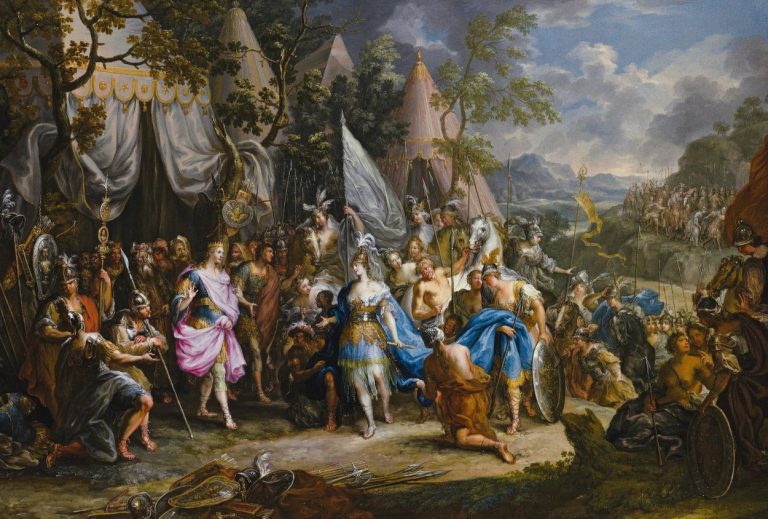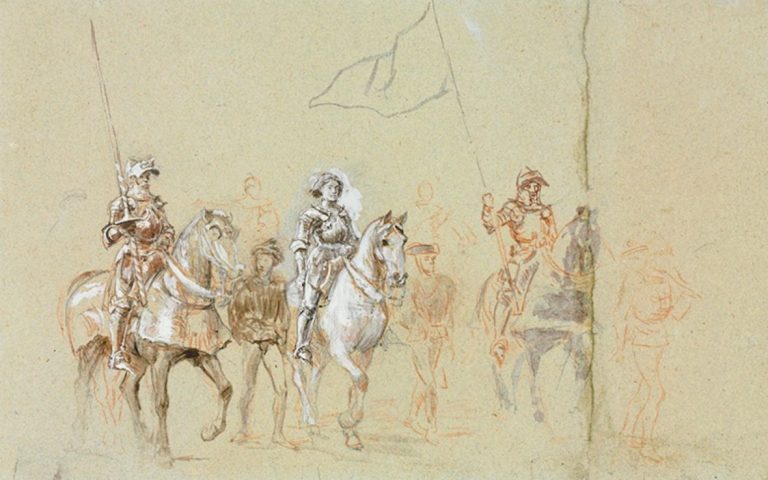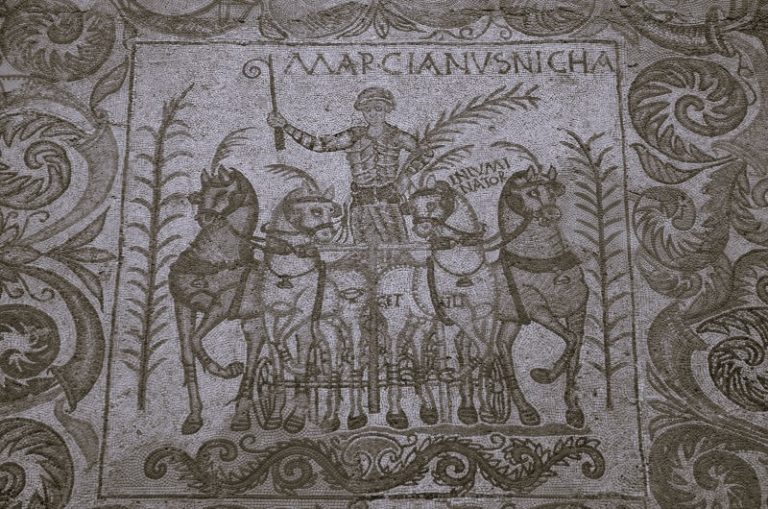
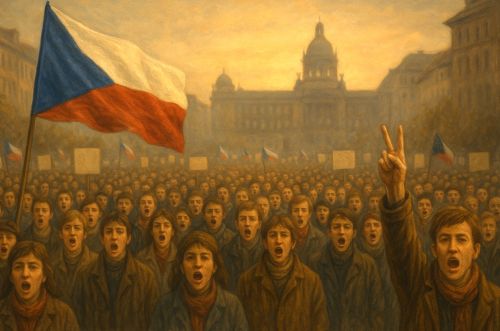
The Velvet Revolution endures as one of modern history’s clearest demonstrations that legitimacy, not violence, anchors political power.

By Matthew A. McIntosh
Public Historian
Brewminate
Introduction
In November 1989, tens of thousands of Czechoslovak students gathered in Prague to commemorate Jan Opletal, a student killed during Nazi occupation in 1939. The march was intended as a quiet remembrance, yet by evening it had become the spark that ignited a nationwide uprising. Within days, hundreds of thousands filled Wenceslas Square, factory floors fell silent in sympathy strikes, and a government that had ruled unchallenged for four decades collapsed without a single shot fired. The “Velvet Revolution,” as it came to be called, remains one of the twentieth century’s most striking examples of peaceful mass mobilization overturning a totalitarian regime.
This revolution’s paradox lies in its simplicity. The Czechoslovak Communist Party commanded an extensive coercive apparatus (its Interior Ministry, secret police (StB), and People’s Militia numbered in the tens of thousands) yet it proved powerless when confronted by hundreds of thousands of unarmed citizens armed only with candles, keys, and collective resolve. As political sociologist Lester Kurtz has observed, “When legitimacy dissolves faster than coercion can respond, the monopoly of force disintegrates.”1 The Velvet Revolution thus illustrates a recurring truth in political history: when the governed withdraw consent on a massive scale, the instruments of repression can no longer function as designed.
What follows examines how that process unfolded. It argues that the Velvet Revolution succeeded not simply because people protested, but because scale, strategy, and circumstance converged to make repression politically impossible. The regime’s internal fragility (exposed by economic stagnation, loss of ideological confidence, and Soviet leader Mikhail Gorbachev’s renunciation of armed intervention) created conditions in which a nonviolent movement could escalate rapidly. Once visible participation reached a critical mass, elites began to defect, security forces hesitated, and power effectively migrated from the party hierarchy to the civic forums negotiating in its place.
The Velvet Revolution has inspired a wide historiography linking it to theories of civil resistance, democratization, and “threshold effects” in collective action. Timothy Garton Ash described the uprisings of 1989 as “revolutions of the mind as much as of the street,” emphasizing the moral drama of truth confronting power.2 Later scholars such as Sharon Wolchik and Jacques Rupnik situated Czechoslovakia’s case within broader patterns of Eastern European transitions, highlighting both its exceptional nonviolence and its structural resemblance to other late-Communist collapses.3 What follows builds on that scholarship but seeks to foreground a specific dynamic: how peaceful scale itself (visible, cumulative, and morally charged) functions as a decisive weapon in systems dependent on fear.
Through a combination of historical narrative and analytical reconstruction, the following sections trace the Revolution’s preconditions, its mobilization dynamics, the tipping point at which authority reversed, and its aftermath in democratic consolidation. By situating these events within both Czechoslovakia’s internal history and comparative theories of nonviolent power, the essay aims to illuminate a principle as relevant now as it was in 1989: when the number of citizens willing to stand together exceeds the state’s capacity or will to suppress them, the foundation of authoritarian control dissolves, not with the roar of artillery, but with the sound of keys in unison.
Historical and Structural Preconditions
The Long Shadow of 1968: From Prague Spring to Normalization
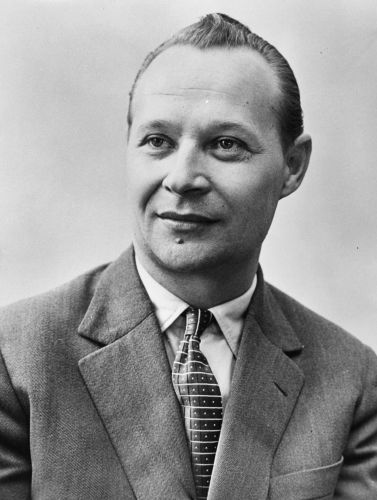
The Velvet Revolution cannot be understood without the memory of another failed revolution, Prague, 1968. That brief experiment in “socialism with a human face,” led by Alexander Dubček, sought to liberalize Czechoslovakia’s political and cultural life within a socialist framework. The Warsaw Pact invasion that crushed it in August 1968 reimposed authoritarian conformity, but the repression that followed inadvertently created the soil in which later dissent would take root.
Writers, artists, and intellectuals were purged or silenced, yet they preserved networks of trust and alternative communication through samizdat publications and underground theatre.4 As historian Padraic Kenney notes, “Normalization did not end politics; it privatized resistance until it was ready to surface again.”5
By the late 1970s, dissident culture had coalesced around Charter 77, a civic initiative demanding that the regime honor human rights provisions it had signed in the Helsinki Accords. Figures like Václav Havel, Jiří Dienstbier, and Jan Patočka framed dissent as a moral stance rather than a partisan project, arguing that “living in truth” itself constituted resistance.6 Their networks would later form the backbone of the 1989 Civic Forum, demonstrating how decades of suppressed civil society quietly sustained the capacity for coordinated action when opportunity returned. The moral authority accumulated through these underground circles would prove as crucial as any logistical preparation.
Economic Stagnation and the Erosion of Legitimacy
By the 1980s, Czechoslovakia, once among the most industrialized states in the Eastern Bloc, had entered deep economic stagnation. Rigid central planning, obsolete technology, and chronic inefficiency had eroded living standards.7 Shortages of consumer goods and environmental degradation, especially in the industrial north, undercut the regime’s claims of socialist progress.8 The state’s social contract, political obedience in exchange for material security, was breaking down.
At the same time, new information leaks and Western broadcasts, including those from Radio Free Europe, eroded censorship’s effectiveness.9 The public could increasingly compare Czechoslovakia’s stagnation with the relative openness emerging under Mikhail Gorbachev’s reforms in the Soviet Union. When Gorbachev made clear that Moscow would no longer enforce orthodoxy by force, the so-called “Sinatra Doctrine,” the protective umbrella under which local Communist elites had ruled vanished almost overnight.10 What had once seemed an immovable order now appeared brittle and outdated, exposed as dependent on fear rather than consent.
Fractures Within the Regime and the Security Apparatus
The Communist Party of Czechoslovakia (KSČ) entered the late 1980s deeply divided between reformists, hardliners, and a weary bureaucratic middle. Party leader Miloš Jakeš lacked both charisma and legitimacy; his speeches, often ridiculed even within official circles, revealed how out of touch the leadership had become.11 Internal reports from the StB (state security) indicated growing reluctance among rank-and-file officers to use force against civilians, a hesitation that mirrored broader social exhaustion with repression.12
This bureaucratic fatigue intersected with generational change. Many younger officers and civil servants were unwilling to risk their careers or reputations for a discredited regime.13 The lesson of Romania’s December 1989 bloodshed, still weeks away but already feared as a possibility, reinforced the logic of restraint. In that fragile equilibrium, even a single act of state violence risked delegitimizing the entire apparatus. The Communists’ decision to avoid a Tiananmen-style crackdown was less moral than pragmatic: they no longer believed they could win such a confrontation.14
Civil Society and the Culture of Everyday Resistance
Despite decades of surveillance, ordinary Czechs and Slovaks developed subtle forms of civic resilience, apolitical on the surface but socially binding beneath. Cultural clubs, theatre troupes, church groups, and environmental associations became informal laboratories of autonomy.15 In these spaces, people relearned the habits of cooperation and trust that authoritarian systems seek to extinguish. When protests began in November 1989, these latent networks activated with remarkable speed, transforming spontaneous outrage into organized civic pressure.
As political theorist Václav Benda wrote in 1987 that the parallel polis is not an imitation of power, but the exercise of truth in a place where lies rule.16 This philosophy of parallel society, living as though one were already free, meant that by the time students took to the streets, the infrastructure of dissent was already built. The Velvet Revolution, then, was not a sudden awakening but a culmination of two decades of quiet preparation.
Mobilization: From Spark to Mass Movement
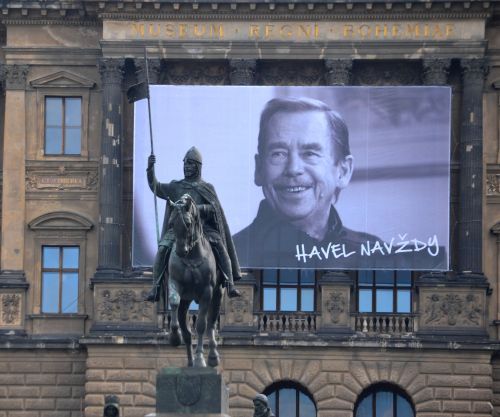
On the evening of 17 November 1989, Prague’s students assembled to mark the fiftieth anniversary of Jan Opletal’s death at Nazi hands, a legally sanctioned commemoration that the regime underestimated. What began as a memorial march became an eruption of civic energy when police units trapped and beat demonstrators on Národní třída.17 News of the violence spread quickly through underground networks and Western radio, inflaming a public already weary of deceit. A rumor that a student, Martin Šmíd, had been killed, though false, became a symbolic truth about the regime’s moral bankruptcy.18 Within forty-eight hours, candlelit vigils appeared across the country, and the first tremor of coordinated protest shook a government unaccustomed to spontaneous crowds.
The state’s attempt at containment failed because it misread both scale and sentiment. By 19 November, theaters in Prague had closed in solidarity, transforming cultural spaces into civic forums. In the Laterna Magika theater that evening, playwright Václav Havel and other dissidents founded Civic Forum, declaring that “the government has lost the confidence of the nation.”19 Across Slovakia, a parallel movement, Public Against Violence, formed with similar demands. The two organizations quickly coordinated through informal channels, issuing joint calls for dialogue, release of political prisoners, and resignation of the Communist leadership. Their tone remained scrupulously nonviolent, appealing to moral conscience rather than vengeance, an approach that resonated deeply with a population fatigued by decades of fear.
The symbolism of the early demonstrations was as deliberate as their logistics. In Prague’s Wenceslas Square, crowds jingled keys in unison, a gesture meaning both “it’s time to go home” and “we hold the keys to our own freedom.”20 Handwritten banners invoked truth, love, and the absurd: “We are not against you; we are against lies.” The visual culture of protest (candles, music, ironic humor) converted urban space into a theater of collective dignity. This was a revolution staged as a moral drama, where performance replaced violence as the language of resistance.21 Even the police, surrounded by chanting families, began to soften their posture, unsure whether to salute or retreat.
The momentum was self-reinforcing. Each day’s turnout exceeded the last, 20,000 on the 18th, 200,000 by the 20th, and over half a million by the 25th.22 Factories organized strike committees; state television employees defied censorship to broadcast fragments of the rallies.23 When the regime tried to address the nation on 24 November, its monotone appeals for calm only highlighted the collapse of credibility. The general strike of 27 November, supported by an estimated three-quarters of the workforce, demonstrated that the party no longer commanded obedience even in workplaces it once controlled.24 What made this strike extraordinary was not its economic impact but its choreography: a precisely timed two-hour halt, a nation holding its breath together, proving that civil society, not the state, now synchronized public life.
Inside the Communist Party, panic turned to paralysis. Hardliners argued for restoring order through emergency powers, but no ministry could guarantee compliance. The army signaled neutrality; the StB reported confusion among its own ranks.25 On 29 November, the Federal Assembly abolished the constitutional clause granting the Communist Party a “leading role,” formally ending single-party rule.26 By December, Havel was president. The entire process, from the first protest to regime collapse, had taken less than six weeks, a velocity that astonished even participants. What military power had maintained for forty years, moral power dissolved through sheer numerical magnitude and public visibility.
In retrospect, the Velvet Revolution exemplifies what political theorist Gene Sharp called the “withdrawal of consent,” the point at which the governed cease performing the routines that sustain authority.27 But Czechoslovakia’s case adds nuance: legitimacy eroded not simply because individuals refused obedience, but because hundreds of thousands did so simultaneously, publicly, and peacefully. In a system whose strength derived from isolation and secrecy, such visibility was fatal. The crowd’s size was not only a measure of resistance; it was its weapon.
Tipping Dynamics and the Power of Numbers
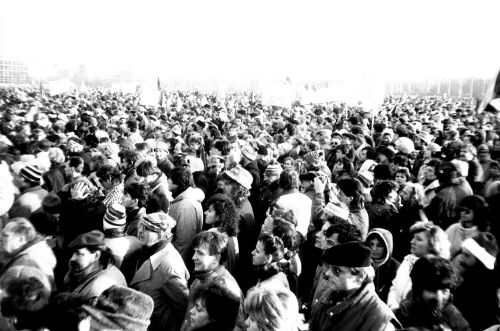
Every revolution depends on perception as much as participation. In November 1989, the decisive variable was not the absolute number of protesters but how those numbers reshaped what citizens, soldiers, and leaders believed to be possible. When hundreds of thousands filled Wenceslas Square, the crowd became its own argument, proof that fear had shifted sides. The police saw it, foreign journalists transmitted it, and even party loyalists began to grasp that the public had become the new center of gravity. The line separating the rulers from the ruled had vanished; suddenly it was we who decided what would happen next.28
Social scientists describe this phenomenon as a threshold cascade: when participation crosses a visible threshold, it triggers imitation and erodes deterrence.29 In Czechoslovakia, years of atomized discontent, grumbling in private kitchens, erupted into public affirmation once people realized they were no longer alone. Each successive crowd expanded the moral and strategic costs of repression.30 The Communist Party’s monopoly on spectacle, once maintained through orchestrated parades, now dissolved in spontaneous assemblies that dwarfed official ceremonies. Authority requires an audience that consents to its script; the Velvet Revolution rewrote that script in the open air.
The government’s paralysis in the face of these numbers reflected a deeper structural truth about modern authoritarianism: repression is sustainable only when it appears limited and legitimate.31 To preserve that illusion, the regime depended on a disciplined coercive core (police, army, and security services) whose members must believe both in the system’s durability and in their isolation from the public. When crowds exceed that psychological boundary, coercion risks self-destruction.32 In Prague, this was precisely the tipping point reached by the third week of demonstrations. Soldiers refused deployment orders, police fraternized with protesters, and Interior Ministry officials privately warned that “any large-scale use of force could provoke a national strike.”33
The moral theater of mass nonviolence amplified the regime’s loss of control. Western television images of candlelight and children on their parents’ shoulders contrasted sharply with the party’s rhetoric of “anti-socialist provocation.”34 Foreign embassies reported that even state television crews were breaking ranks, using sympathetic camera angles and lingering on faces of ordinary people rather than officials.35 Once the media apparatus began reflecting rather than filtering public sentiment, the government’s claim to represent the people became untenable. The number of demonstrators, by then surpassing half a million, was not merely demographic but epistemic: it redefined truth through visibility.
This transformation of scale into legitimacy underscores a recurring pattern in nonviolent revolutions. As the International Center on Nonviolent Conflict notes, “When coercive resources cannot be applied without destroying the state’s remaining legitimacy, power shifts from command to consent.”36 In Czechoslovakia, that transfer was accelerated by elite defection. Members of the Federal Assembly, long obedient, began resigning publicly; regional party officials met secretly with Civic Forum envoys to negotiate their exit.37 The revolution did not conquer the state, it hollowed it out until the facade collapsed under its own weight.
The Velvet Revolution thus crystallized a paradox at the heart of modern political order: an authoritarian regime may control the instruments of violence, but the numerical superiority of the governed always contains a latent veto.38 What distinguishes successful uprisings from failed ones is not courage alone but synchronization—when enough individuals act together, the state’s calculus of control reverses. In 1989, the Czechoslovak people discovered that principle in practice, proving that sheer scale, organized peace, and moral clarity can unravel a dictatorship more swiftly than armed insurrection ever could.
Outcome, Consolidation, and Limitations
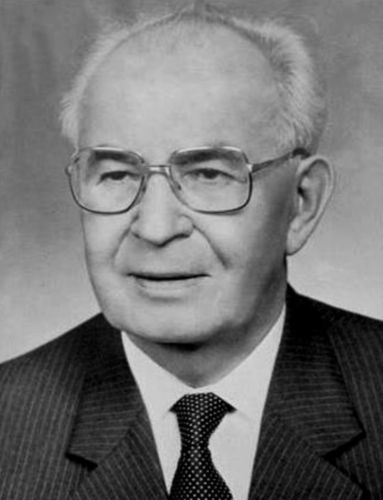
The final week of 1989 in Czechoslovakia compressed decades of deferred change into days. On 10 December, President Gustáv Husák swore in a coalition government led by non-Communists, then resigned, symbolically closing the era of party rule.39 Two weeks later, the Federal Assembly elected Václav Havel president, the imprisoned dissident now standing in the Castle once reserved for Communist elites.40 The transfer was astonishingly bloodless. Yet the very speed that made the Velvet Revolution a triumph of moral unity also created structural fragility: new institutions had to be built faster than the old ones could decay.
The first task was political reconstruction. Civic Forum and Public Against Violence, hastily formed as protest coalitions, now found themselves serving as interim political forces.41 They advocated free elections, the restoration of civil rights, and a market-oriented economy. Their success in June 1990 parliamentary elections confirmed broad popular support but also revealed fragmentation: the movements lacked coherent ideology beyond anti-authoritarian consensus.42 As sociologist Jiřina Šiklová observed, “We knew what we did not want; we had not yet learned what we wanted.”43 That vacuum left space for technocrats and economic reformers to set the transition’s pace, sometimes at odds with the egalitarian spirit of 1989.
Economic transformation proved especially wrenching. Under Finance Minister Václav Klaus, the government embarked on “shock therapy,” rapid privatization and liberalization aimed at integrating Czechoslovakia into global markets.44 Inflation surged, state enterprises collapsed, and unemployment, previously disguised under socialism, became visible for the first time.45 Although GDP eventually recovered, many citizens felt betrayed by the abrupt shift from collective solidarity to competitive individualism. The revolution that had promised moral renewal now seemed to deliver social stratification.46 This tension foreshadowed the populist disillusionment that would shadow many post-communist democracies.
Institutionally, the new government prioritized democratization and legal reform. The 1990 Constitution abolished Marxist-Leninist doctrine as a state ideology and guaranteed freedoms of speech, association, and religion.47 The dreaded Státní bezpečnost (StB) was dissolved, its archives partially opened to public scrutiny.48 Yet the process of lustration, excluding former secret-police collaborators from office, proved divisive. Some viewed it as moral cleansing; others as vengeance incompatible with the revolution’s conciliatory ethos.49 In practice, inconsistent enforcement allowed many bureaucratic networks to persist under new titles, illustrating how deeply authoritarian habits can outlive regimes.
Another challenge was national pluralism. The Czechoslovak federation, maintained for seventy years by alternating coercion and compromise, now faced divergent political trajectories. While the Czech lands favored rapid economic reform and Western integration, Slovak leaders demanded greater autonomy. Negotiations over constitutional competencies collapsed in 1992, leading to the peaceful “Velvet Divorce” on 1 January 1993.50 Both successor states preserved democratic frameworks, but the split underscored how the unity of 1989 had been tactical rather than organic. As historian Mary Heimann remarks, “The revolution united Czechs and Slovaks against something, not necessarily for the same thing.”51
Despite these fissures, the Velvet Revolution’s moral legacy endured. It reintroduced the language of conscience into public life and demonstrated that a state built on fear could be dismantled without bloodshed. Havel’s presidency symbolized the fusion of ethics and politics, insisting that “truth and love must prevail over lies and hatred.”52 Yet the ensuing decade also revealed the paradox of moral revolutions: virtue cannot substitute for governance. By the mid-1990s, voter turnout had declined, Civic Forum dissolved, and the technocratic pragmatism of Klaus’s “velvet capitalism” replaced the idealism of candlelight squares. Still, the precedent of 1989 remained intact, a reminder that the consent of the governed, once withdrawn, is rarely recoverable by force.
Theoretical Implications and Broader Lessons
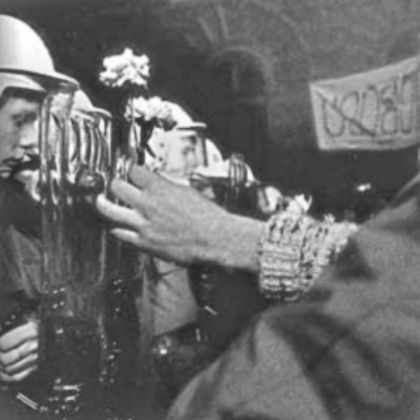
The Velvet Revolution has often been cited as proof that power ultimately depends on consent rather than coercion. Yet its deeper theoretical significance lies in how it redefines the mechanics of that consent. Czechoslovakia’s experience demonstrates that authoritarian systems are not dismantled by moral appeal alone but by the systematic erosion of obedience through scale, organization, and public visibility. Political power, as Hannah Arendt argued, “springs up whenever people act together,” and vanishes when they fall apart.53 In November 1989, millions momentarily rediscovered this collective capacity for action, transforming a scattered population into what sociologist Charles Tilly would call a “mobilized polity.”54
Several conditions of success emerge from the Czechoslovak case. First was the presence of a robust civic infrastructure capable of coordinating rapid action. Networks formed by Charter 77, underground artists, and church groups provided the logistical scaffolding that allowed the student protests to evolve into a nationwide movement within days.55 Second was the regime’s loss of external and internal support. With Gorbachev’s renunciation of intervention, the Communist leadership could no longer rely on Soviet tanks to enforce authority, while at home its own functionaries doubted the cause they served.56 Third was the disciplined nonviolence of the demonstrators. Their refusal to retaliate against police aggression deprived the regime of the pretext for repression and invited sympathy from soldiers and bystanders.57 Each of these elements interacted to produce the “tipping cascade” described earlier: structure created opportunity, and behavior exploited it.
Comparatively, the Velvet Revolution aligns with patterns identified by Erica Chenoweth and Maria Stephan, who found that nonviolent campaigns are more than twice as likely to succeed as violent ones because they attract broader participation and induce elite defections.58 Yet Czechoslovakia also warns against overgeneralization. Its revolution succeeded under conditions of a weakening hegemon, a homogeneous population, and relative openness to Western media, variables absent in more repressive settings such as China in the same year.59 The implication is not that nonviolence universally triumphs, but that its efficacy depends on an ecosystem of vulnerability within the ruling elite. Where coercive cohesion remains intact, sheer numbers may still fail to translate into power.
At a conceptual level, the Velvet Revolution challenges deterministic models of revolution that equate transformation with violence. Instead, it reveals a performative dimension of political change: revolutions succeed when they persuade rather than destroy.60 The keys jangling in Wenceslas Square did not topple walls, but they shattered an illusion—that the state’s authority was limitless and the citizen’s agency negligible. Once that illusion broke, obedience became voluntary, and the government’s fall became procedural.61 As Václav Havel wrote later, “The real revolution was not in the streets but in the human heart.”62 While such rhetoric may sound poetic, it accurately captures the psychological inversion that nonviolent power requires.
For contemporary movements, the lesson is dual. Moral legitimacy without strategic design risks futility, but strategy without moral legitimacy invites repression. The Velvet Revolution succeeded because it fused both. Its leaders cultivated an image of humility and decency while maintaining disciplined coordination and a clear timetable of demands.63 The result was a revolution that disarmed its adversaries not by threat but by recognition: the regime saw itself mirrored in the faces of its citizens and could no longer sustain its own myth of opposition between ruler and ruled.
In this sense, 1989 remains less a relic than a manual. It teaches that the arithmetic of power always favors the many, but only when they act as one; that violence is not the engine of revolution but its failure; and that the fragility of authoritarianism lies not in its weapons, but in the moment its subjects realize how vastly they outnumber those who hold them.
Conclusion
The Velvet Revolution endures as one of modern history’s clearest demonstrations that legitimacy, not violence, anchors political power. In November 1989, a regime armed with secret police, censors, and soldiers yielded to students carrying flowers and candles. The collapse was not miraculous but mechanical: once enough citizens refused to participate in the performance of obedience, the system lost the capacity to reproduce itself. As Václav Havel later reflected, “The moment people broke through the barrier of fear, they broke through everything.”64
This essay has traced how that moment emerged from decades of repression, quiet civic preparation, and structural decay. The Velvet Revolution succeeded because scale, organization, and moral clarity converged at a precise historical instant. Beneath its gentleness lay strategic rigor: nonviolence was not passivity but calculated disruption of the state’s coercive logic. The Czechoslovak people proved that mass action could neutralize violence not by matching it, but by exposing its futility. When the rulers’ commands ceased to be executed, their power evaporated, proof of Arendt’s observation that “violence can destroy power; it is utterly incapable of creating it.”65
The revolution’s legacy, however, extends beyond its own borders. Its pattern (moral leadership, disciplined nonviolence, and the visible withdrawal of consent) has recurred in movements from Serbia’s Otpor! to Ukraine’s Orange Revolution and Tunisia’s Jasmine Revolution.66 Yet the Czechoslovak experience also issues a caution: moral victory does not guarantee democratic consolidation. The unity of the square dissipates once pluralism returns; the habits of freedom must be learned anew. Still, the Velvet Revolution reminds scholars and citizens alike that no government, however entrenched, is stronger than the collective refusal of those it governs to comply.
In the end, the revolution was neither a miracle of history nor an accident of circumstance, but a rediscovery of proportion. A state’s power rests on the obedience of millions to the orders of a few; when those proportions invert, history moves. Czechoslovakia’s 1989 proved that the quiet majority, once awakened, can dismantle empires without firing a shot, and that the true measure of political strength lies not in the weapons one holds, but in the number who still believe they must obey.
Appendix
Footnotes
- Lester R. Kurtz, Czechoslovakia’s Velvet Revolution (1989) (Washington, DC: International Center on Nonviolent Conflict, 2005), 14.
- Timothy Garton Ash, The Magic Lantern: The Revolution of ’89 Witnessed in Warsaw, Budapest, Berlin, and Prague (New York: Random House, 1990), 10.
- Sharon L. Wolchik, “Czechoslovakia’s Gentle Revolution.” In Central and East European Politics: From Communism to Democracy, edited by Sharon L. Wolchik and Jane Leftwich Curry. Lanham, MD: Rowman & Littlefield, 2010.; Jacques Rupnik, The Other Europe: The Rise and Fall of Communism in East-Central Europe (New York: Pantheon, 1989), 268–275.
- Kieran Williams, The Prague Spring and Its Aftermath: Czechoslovak Politics, 1968–1970 (Cambridge: Cambridge University Press, 1997), 201–203.
- Padraic Kenney, A Carnival of Revolution: Central Europe, 1989 (Princeton: Princeton University Press, 2002), 42.
- Václav Havel, “The Power of the Powerless,” in Open Letters: Selected Writings, 1965–1990 (New York: Vintage, 1992), 125–214.
- Jacques Rupnik, “The European Union and the Eastern Dilemma.” The Brown Journal of World Affairs 1, no. 2 (Spring 1994): 129-138.
- Melissa Feinberg, Elusive Equality: Gender, Citizenship, and the Limits of Democracy in Czechoslovakia, 1918–1950 (Pittsburgh: University of Pittsburgh Press, 2006), 189–191.
- Arch Puddington, Broadcasting Freedom: The Cold War Triumph of Radio Free Europe and Radio Liberty (Lexington: University Press of Kentucky, 2000), 212.
- Mark Kramer, “The Collapse of East European Communism and the Repercussions within the Soviet Union (Part One),” Journal of Cold War Studies 5, no. 4 (2003): 184–185.
- Oldřich Tůma, The Fall of Communism in Czechoslovakia: A Chronology, 1987–1991 (Prague: Institute for Contemporary History, 1999), 33.
- “Report on the Situation within the Ministry of the Interior,” in The Czechoslovak Crisis: Documents from the State Security Archives, 1989, ed. Prokop Tomek (Prague: Security Services Archive, 2009), 47–48.
- Mary Heimann, Czechoslovakia: The State That Failed (New Haven: Yale University Press, 2009), 359–361.
- Jacques Rupnik, The Other Europe: The Rise and Fall of Communism in East-Central Europe (New York: Pantheon, 1989), 273–275.
- Jan Urban, “Civil Society and the Velvet Revolution: Mobilizing for Democracy in Czechoslovakia.” Cosmos Working Papers 2012, no. 4 (1989).
- Václav Benda, “The Parallel Polis,” in The Power of the Powerless: Citizens Against the State in Central Eastern Europe, ed. Václav Havel et al. (Armonk, NY: M.E. Sharpe, 1979), 231.
- Oldřich Tůma, The Fall of Communism in Czechoslovakia: A Chronology, 1987–1991 (Prague: Institute for Contemporary History, 1999), 45–47.
- Radio Free Europe/Radio Liberty, “Unraveling the Šmíd Death Story,” About RFE/RL, 2019, https://about.rferl.org/article/unraveling-the-smid-death-story/.
- Václav Havel, “Civic Forum Declaration,” 17 November 1989, in Revolution by Candlelight: Documents of Czechoslovakia’s Velvet Revolution, ed. Jiří Pehe (Prague: Open Society Archives, 1999), 8–9.
- “Czechoslovakians Campaign for Democracy (Velvet Revolution), 1989,” Global Nonviolent Action Database, Swarthmore College, https://nvdatabase.swarthmore.edu/content/czechoslovakians-campaign-democracy-velvet-revolution-1989.
- James Krapfl, Revolution with a Human Face: Politics, Culture, and Community in Czechoslovakia, 1989–1992 (Ithaca: Cornell University Press, 2013), 61.
- The Magic Lantern, dir. Krzysztof Kieślowski (Prague: Film Studio Barrandov, 1990); see also Lester R. Kurtz, Czechoslovakia’s Velvet Revolution (1989) (Washington, DC: International Center on Nonviolent Conflict, 2005), 22–24.
- “Television Workers Join Protest,” BBC Summary of World Broadcasts, 23 November 1989.
- “General Strike in Czechoslovakia,” New York Times, 27 November 1989.
- “Report of the Central Committee Meeting,” in The Czechoslovak Crisis: Documents from the State Security Archives, 1989, ed. Prokop Tomek (Prague: Security Services Archive, 2009), 95–97.
- Kieran Williams, The Czech and Slovak Republics: Nation versus State (New York: Routledge, 1997), 15–16.
- Gene Sharp, From Dictatorship to Democracy: A Conceptual Framework for Liberation (Boston: Albert Einstein Institution, 1994), 48–49.
- Václav Havel, Disturbing the Peace: A Conversation with Karel Hvížďala (New York: Vintage, 1986), 187.
- Mark Granovetter, “Threshold Models of Collective Behavior,” American Journal of Sociology 83, no. 6 (1978): 1420–1443.
- Kurt Weyland, “The Arab Spring: Why the Surprising Similarities with the Revolutionary Wave of 1848?” Perspectives on Politics 10, no. 4 (2012): 918–919.
- Charles Tilly, From Mobilization to Revolution (Reading, MA: Addison-Wesley, 1978), 181–182.
- Erica Chenoweth and Maria J. Stephan, Why Civil Resistance Works: The Strategic Logic of Nonviolent Conflict (New York: Columbia University Press, 2011), 50–51.
- “Internal Report of the Ministry of the Interior, 23 November 1989,” in The Czechoslovak Crisis: Documents from the State Security Archives, 1989, ed. Prokop Tomek (Prague: Security Services Archive, 2009), 102.
- “Czechoslovak Television Reports on Demonstrations,” BBC Summary of World Broadcasts, 25 November 1989.
- U.S. Embassy Prague, “Cable to State Department: Public Mood and Regime Response,” 26 November 1989, in National Security Archive Electronic Briefing Book No. 141, George Washington University.
- Lester R. Kurtz, Czechoslovakia’s Velvet Revolution (1989) (Washington, DC: International Center on Nonviolent Conflict, 2005), 28.
- Kieran Williams, The Czech and Slovak Republics: Nation versus State (New York: Routledge, 1997), 19–20.
- Hannah Arendt, On Violence (New York: Harcourt Brace, 1970), 44–45.
- Oldřich Tůma, “The Final Decade of the Communist Regime in Czechoslovakia.” Demokratiezentrum Wien (October 2007).
- “Vaclav Havel Elected President,” New York Times, 30 December 1989.
- Lester R. Kurtz, Czechoslovakia’s Velvet Revolution (1989) (Washington, DC: International Center on Nonviolent Conflict, 2005), 31–33.
- Jacques Rupnik, “Eastern Europe: The International Context,” Journal of Democracy 1, no. 2 (1990): 23–26.
- Ibid.
- Jan Svejnar, “Transition Economics: Performance and Challenges,” Journal of Economic Perspectives 16, no. 1 (2002): 7–9.
- Anders Åslund, How Capitalism Was Built: The Transformation of Central and Eastern Europe, Russia, and Central Asia (Cambridge: Cambridge University Press, 2007), 142.
- David Ost, The Defeat of Solidarity: Anger and Politics in Postcommunist Europe (Ithaca: Cornell University Press, 2005), 32–33.
- Kieran Williams, The Czech and Slovak Republics: Nation versus State (New York: Routledge, 1997), 27–29.
- Jiří Lustig, “Memory of Nations Project.” 2008-2025: https://www.memoryofnations.eu/en/lustig-jiri-1933#:~:text=Ji%C5%99%C3%AD%20Lustig%20was%20born%20on,various%20positions%20until%20his%20retirement.
- Roman David, Lustration and Transitional Justice: Personnel Systems in the Czech Republic, Hungary, and Poland (Philadelphia: University of Pennsylvania Press, 2011), 63–66.
- Karen Henderson, Slovakia: The Escape from Invisibility (London: Routledge, 2002), 53–56.
- Mary Heimann, Czechoslovakia: The State That Failed (New Haven: Yale University Press, 2009), 374.
- Václav Havel, New Year’s Address to the Nation, 1 January 1990, in Vaclav Havel: Living in Truth, ed. Jan Vladislav (London: Faber and Faber, 1990), 302.
- Hannah Arendt, The Human Condition (Chicago: University of Chicago Press, 1958), 200.
- Charles Tilly, Contentious Performances (Cambridge: Cambridge University Press, 2008), 13.
- Padraic Kenney, A Carnival of Revolution: Central Europe, 1989 (Princeton: Princeton University Press, 2002), 117–119.
- Mark Kramer, “The Collapse of East European Communism and the Repercussions within the Soviet Union (Part One),” Journal of Cold War Studies 5, no. 4 (2003): 184–186.
- Lester R. Kurtz, Czechoslovakia’s Velvet Revolution (1989) (Washington, DC: International Center on Nonviolent Conflict, 2005), 29.
- Erica Chenoweth and Maria J. Stephan, Why Civil Resistance Works: The Strategic Logic of Nonviolent Conflict (New York: Columbia University Press, 2011), 7.
- Andrew J. Nathan, “China’s Crisis: Dilemmas of Reform and Prospects for Democracy.” The Journal of Asian Studies 49, no. 4 (1990): 912-937.
- James Krapfl, Revolution with a Human Face: Politics, Culture, and Community in Czechoslovakia, 1989–1992 (Ithaca: Cornell University Press, 2013), 68–70.
- Gene Sharp, From Dictatorship to Democracy: A Conceptual Framework for Liberation (Boston: Albert Einstein Institution, 1993), 50.
- Václav Havel, To the Castle and Back (New York: Alfred A. Knopf, 2007), 22.
- Sharon L. Wolchik, “Czechoslovakia’s Gentle Revolution.” In Central and East European Politics: From Communism to Democracy, edited by Sharon L. Wolchik and Jane Leftwich Curry. Lanham, MD: Rowman & Littlefield, 2010.
- Václav Havel, Summer Meditations (New York: Alfred A. Knopf, 1992), 9.
- Hannah Arendt, On Violence (New York: Harcourt Brace, 1970), 56.
- Erica Chenoweth, “The Future of Nonviolent Resistance,” Journal of Democracy 31, no. 3 (2020): 69–70.
Bibliography
- Arendt, Hannah. The Human Condition. Chicago: University of Chicago Press, 1958.
- ———. On Violence. New York: Harcourt Brace, 1970.
- Åslund, Anders. How Capitalism Was Built: The Transformation of Central and Eastern Europe, Russia, and Central Asia. Cambridge: Cambridge University Press, 2007.
- Ash, Timothy Garton. The Magic Lantern: The Revolution of ’89 Witnessed in Warsaw, Budapest, Berlin, and Prague. New York: Random House, 1990.
- Benda, Václav. “The Parallel Polis.” In The Power of the Powerless: Citizens Against the State in Central Eastern Europe, edited by Václav Havel et al., 231–247. Armonk, NY: M.E. Sharpe, 1979.
- Chenoweth, Erica. “The Future of Nonviolent Resistance.” Journal of Democracy 31, no. 3 (2020): 69–70.
- Chenoweth, Erica, and Maria J. Stephan. Why Civil Resistance Works: The Strategic Logic of Nonviolent Conflict. New York: Columbia University Press, 2011.
- David, Roman. Lustration and Transitional Justice: Personnel Systems in the Czech Republic, Hungary, and Poland. Philadelphia: University of Pennsylvania Press, 2011.
- Feinberg, Melissa. Elusive Equality: Gender, Citizenship, and the Limits of Democracy in Czechoslovakia, 1918–1950. Pittsburgh: University of Pittsburgh Press, 2006.
- Granovetter, Mark. “Threshold Models of Collective Behavior.” American Journal of Sociology 83, no. 6 (1978): 1420–1443.
- Havel, Václav. Disturbing the Peace: A Conversation with Karel Hvížďala. New York: Vintage, 1986.
- ———. New Year’s Address to the Nation, 1 January 1990. In Vaclav Havel: Living in Truth, edited by Jan Vladislav, 302. London: Faber and Faber, 1990.
- ———. Summer Meditations. New York: Alfred A. Knopf, 1992.
- ———. To the Castle and Back. New York: Alfred A. Knopf, 2007.
- ———. “The Power of the Powerless.” In Open Letters: Selected Writings, 1965–1990, 125–214. New York: Vintage, 1992.
- Heimann, Mary. Czechoslovakia: The State That Failed. New Haven: Yale University Press, 2009.
- Henderson, Karen. Slovakia: The Escape from Invisibility. London: Routledge, 2002.
- Krapfl, James. Revolution with a Human Face: Politics, Culture, and Community in Czechoslovakia, 1989–1992. Ithaca: Cornell University Press, 2013.
- Kramer, Mark. “The Collapse of East European Communism and the Repercussions within the Soviet Union (Part One).” Journal of Cold War Studies 5, no. 4 (2003): 184–186.
- Kenney, Padraic. A Carnival of Revolution: Central Europe, 1989. Princeton: Princeton University Press, 2002.
- Kurtz, Lester R. Czechoslovakia’s Velvet Revolution (1989). Washington, DC: International Center on Nonviolent Conflict, 2005.
- Lustig, Jiří. “Memory of Nations Project.” 2008-2025: https://www.memoryofnations.eu/en/lustig-jiri-1933#:~:text=Ji%C5%99%C3%AD%20Lustig%20was%20born%20on,various%20positions%20until%20his%20retirement.
- Nathan, Andrew J. “China’s Crisis: Dilemmas of Reform and Prospects for Democracy.” The Journal of Asian Studies 49, no. 4 (1990): 912-937.
- Ost, David. The Defeat of Solidarity: Anger and Politics in Postcommunist Europe. Ithaca: Cornell University Press, 2005.
- Puddington, Arch. Broadcasting Freedom: The Cold War Triumph of Radio Free Europe and Radio Liberty. Lexington: University Press of Kentucky, 2000.
- Rupnik, Jacques. The Other Europe: The Rise and Fall of Communism in East-Central Europe. New York: Pantheon, 1989.
- ———. “The European Union and the Eastern Dilemma.” The Brown Journal of World Affairs 1, no. 2 (Spring 1994): 129-138.
- ———. “Eastern Europe: The International Context.” Journal of Democracy 1, no. 2 (1990): 23–26.
- Sharp, Gene. From Dictatorship to Democracy: A Conceptual Framework for Liberation. Boston: Albert Einstein Institution, 1994.
- Svejnar, Jan. “Transition Economics: Performance and Challenges.” Journal of Economic Perspectives 16, no. 1 (2002): 7–9.
- Tilly, Charles. Contentious Performances. Cambridge: Cambridge University Press, 2008.
- ———. From Mobilization to Revolution. Reading, MA: Addison-Wesley, 1978.
- Tůma, Oldřich. “The Final Decade of the Communist Regime in Czechoslovakia.” Demokratiezentrum Wien (October 2007).
- Urban, Jan. “Civil Society and the Velvet Revolution: Mobilizing for Democracy in Czechoslovakia.” Cosmos Working Papers 2012, no. 4 (1989).
- Williams, Kieran. The Prague Spring and Its Aftermath: Czechoslovak Politics, 1968–1970. Cambridge: Cambridge University Press, 1997.
- ———. The Czech and Slovak Republics: Nation versus State. New York: Routledge, 1997.
- Weyland, Kurt. “The Arab Spring: Why the Surprising Similarities with the Revolutionary Wave of 1848?” Perspectives on Politics 10, no. 4 (2012): 918–919.
- Wolchik, Sharon L. “Czechoslovakia’s Gentle Revolution.” In Central and East European Politics: From Communism to Democracy, edited by Sharon L. Wolchik and Jane Leftwich Curry. Lanham, MD: Rowman & Littlefield, 2010.
Originally published by Brewminate, 10.17.2025, under the terms of a Creative Commons Attribution-NonCommercial-NoDerivatives 4.0 International license.
